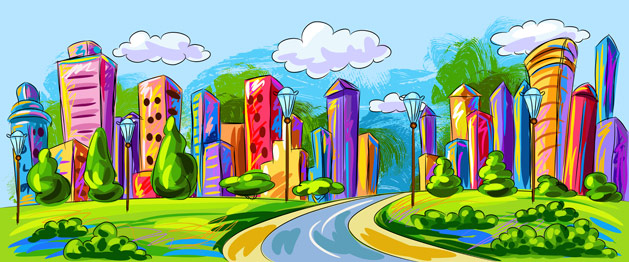Learning in the Creativity Age
Fostering attitudes and constructing environments where creativity thrives

Creativity - and more specifically, our lack of creativity - has become a common topic around water coolers and in boardrooms in the business world, and in hallways, lounges, and in-services days where educators discuss THEIR business. A creativity chasm has developed...on one side, we find those of us with self-imposed labels like “uncreative” or “undercreative” on the other side are the creative projects that are growing increasingly essential to achieve success in today‘s connected world.
Managing creativity in the classroom is often a paradox - some of the behaviors that indicate creativity, such as asking constant, crazy questions, can also pose management problems in a classroom setting. The ability to think creatively - even though practice can be chaotic - is a powerful and important skill. Remember Bloom‘s Taxonomy of Thinking Skills? David Krathwhol, one of the original members of Bloom‘s 1956 team, updated the taxonomy in 2001 and moved “creating” to the highest form of thinking.
The simplest definition of creativity is the capacity for and the creation of something novel and useful. A creative solution doesn‘t need to be entirely novel; creative ideas or products are often a synthesis of existing ideas recombined or re-imagined in a new or original manner.
I like the way that the Association of American Colleges and Universities defines creativity in their Creative Thinking Rubric.
“Creative thinking is both the capacity to combine or synthesize existing ideas, images, or expertise in original ways and the experience of thinking, reacting, and working in an imaginative way characterized by a high degree of innovation.”
Many people think creativity is almost magic. Others consider it a “gift” with which you are born or you aren‘t. We most often associate creativity with the arts, but creativity is essential in every discipline.
Being creative is not a single character trait; it is a response to our environment and collection of behaviors and attitudes. While a rote model for being creative will result in non-creative outcomes, there are techniques we can employ to create an environment where creativity is likely to flourish.
Behaviors and attitudes that foster creativity
The first step toward being creative is embracing the behaviors that support creativity. How we think, our belief in ourselves, and our attitudes towards risk and obstacles make a huge difference in how creative we can be. Adopting the following four attitudes can help you become more creative.
1. Consider alternatives
Think of the creative people you know. It is very likely that most of them can be labeled open-minded. If we are going to come up with truly unique ideas, new ways of doing things, and create revolutionary products that will transform our world, you have to really move yourself outside of what is comfortable and familiar. That is not to say you need to discard your experience and expertise. The more you know, the more intellectual space you have for your mind to wander. Just don‘t let your current realms of knowledge box you in.
Acknowledge your assumptions and then question them. Seeking multiple perspectives and trying to understand point-of-view and perspective can open us up to new ways of seeing things which may lead to connections we never dreamed of. Creativity lives in the gray area...it can be hard to find if you only concentrate on the black and white.
2. Take Risks
All too often we avoid a creative idea or approach because we are afraid of failure. Creative ideas naturally go against the grain. In the words of Sir Ken Robinson, “If you‘re not prepared to be wrong, you‘ll never come up with anything original.” Do something unconventional to shake up your daily routine, even something minimal like changing your route to work or school.
"Most creative work goes at least slightly against the established way of doing things" - Robert Sternberg
Share a new idea starting with “I‘m going to go out on a limb here...” to let others know you are taking a risk and are asking them to be more creative as well.
Taking risks also requires us to founder in uncertainty for a lot longer than most of us are comfortable. If students don‘t answer questions immediately, let everyone sit for a bit, even if it is uncomfortable. Embrace that time as positive. We don‘t like uncertainty, but staying in that place just a little longer can help ideas settle or provide the spark for new ones.
3. Use Your Imagination
It is helpful to observe and explore the world using your senses, but when you use your imagination to create a model of something that isn‘t there, you open yourself up to new possibilities... not just what or how it is, but what or how it could be. An easy way to do this is to think about an object, idea, or process in the future. Since there is no way to know for sure, you have to be creative and imagine.
Start to question! Ask what if? Specifically address and then challenge the assumptions that you have. What other questions can you ask about the topic? Ask open-ended questions. These don‘t expect a single correct answer and encourage imagination.
4. Try Again
I don‘t just mean come up with another idea, like brainstorming, I mean that you need to be tenacious! You have to believe in yourself and your ability to succeed, especially when the work gets very hard and when obstacles to success are presented. Don‘t assume creativity will be easy...and don‘t stop when it gets hard!
Helping Creativity Flourish
If you want to promote creativity in your students, you need to embrace it as a positive trait and expect that your students can do it. Research has shown that if you try to be more creative, or request that your students be more creative, creativity actually occurs.
To create an environment where creativity flourishes:
- Ask open-ended, stimulating questions
- Encourage student questions
- Define and redefine questions
- Challenge assumptions
- Foster curiosity
- Demonstrate respect for questions and ideas
- Embrace “I don‘t know”
- Think across subjects and disciplines
- Tolerate ambiguity
- Provide exposure to different viewpoints
- Encourage risk-taking and reward it
Everyone has the capacity to be creative. I look forward to hearing what you and your students dream up!
References and Additional Reading
Amabile, T. M. (1983). The social psychology of creativity. New York: Springer.
Amabile, T. M. (1998). “How to kill creativity”. Harvard Business Review 76 (5). https://bit.ly/9VqeUk
Association of American Colleges and Universities. Creative Thinking Rubric https://bit.ly/Slq9X3
Baird, B., Smallwood, J., Mrazek, M. D., Kam, J. W. Y., Franklin, M. S., & Schooler, J. W. (2012). Inspired by distraction: Mind wandering facilitates creative incubation. Psychological Science.
Rhodes, M. (1961). An analysis of creativity, Phi Beta Kappen, 42, 305-310.
Robinson, Ken (1998). All our futures: Creativity, culture, education. National Advisory Committee on Creative and Cultural Education. Retrieved 2 October 2010.
Rosenthal, R. and Jacobson, L. (1968) Pygmalion in the classroom: teacher expectation and pupils‘ intellectual development. New York: Holt, Rinehart & Winston.
Sternberg, R.J., & Williams, W. M. (1996). How to develop student creativity. Alexandria, VA: Association for Supervision and Curriculum Development.
Sternberg, R.J. (2006). “The Nature of Creativity”. Creativity Research Journal 18 (1): 87-98.
Torrance, E. P. (1962). Guiding Creative Talent. Englewood Cliffs, NJ: Prentice Hall.















